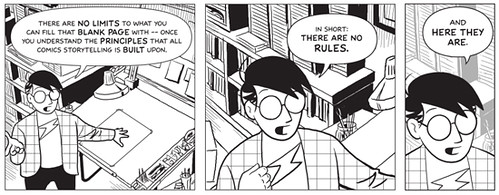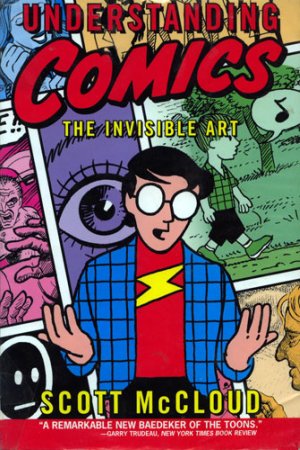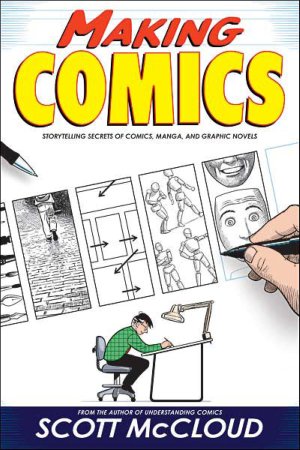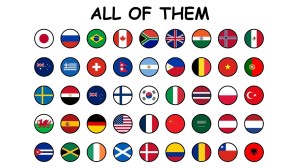Guest post by Aaron Muszalski
Scott McCloud’s Understanding Comics: The Invisible Art is a richly insightful exploration of the medium of comics told, appropriately enough, in comic-book form. Originally published in 1993, it quickly came to be regarded as a classic, not only for helping to elevate sequential art to the same level as other, more “legitimate” art forms but for its engaging, exuberant style. Understanding Comics is an absolute delight to read, full of humor and the author’s obviously deep affection for the unique magic that only comics can achieve.
But what makes Understanding Comics truly great is its scope. For in order to properly redefine how comics were viewed relative to other forms of art, McCloud first needed to define art itself. All art, from the origin of humankind through the era of mechanical reproduction and beyond. That he succeeded at such an ambitious task is not half as surprising as the fact that the result is so supremely accessible. Understanding Comics is no less than a comprehensive primer on human perception, creativity, storytelling, representation, abstraction, empathy and a million points in between.
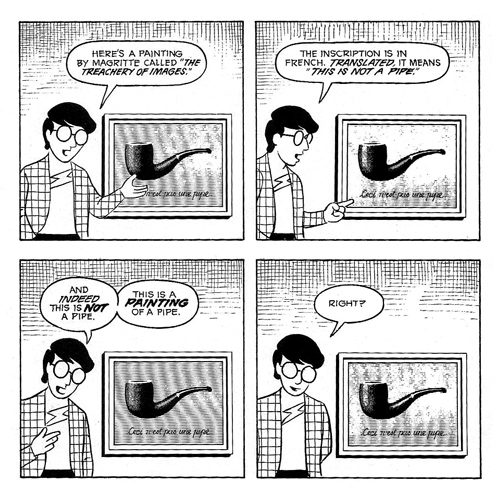
This breadth earned McCloud accolades from a diverse range of fans, including Apple Macintosh co-creator Andy Hertzfeld, who provocatively called Understanding Comics “one of the most insightful books about designing graphic user interfaces ever written.” Stewart Brand, Co-Founder of The Long Now Foundation, described Understanding Comics as “a seminal work at the level of Edward Tufte’s Envisioning Information.” And Alan Moore, the famed writer behind such modern comic classics as Watchmen, declared Understanding Comics to be “quite simply the best analysis of the medium that I have ever encountered.”

Propelled by this cross-disciplinary seal of approval, Understanding Comics became essential reading for anyone working in graphic communication during the 90’s, from user interface designers to CD-ROM developers and, eventually, many of the early pioneers of the World Wide Web. Born of a love for comics, McCloud’s far-reaching insights inspired a generation of information architects and helped to shape the form of the Internet.
McCloud enthusiastically embraced the Internet himself, and was one of the earliest proponents of both webcomics and micropayments, concepts he explored in the sequel to Understanding Comics, 2000’s Reinventing Comics. Like Understanding Comics, Reinventing Comics was also told entirely in comic form. In it, McCloud described “12 revolutions” that were necessary for the comics medium to survive. A controversial book, Reinventing Comics was not as successful as its predecessor, and even McCloud himself now describes it as “wordy, dogmatic” and containing “genuine flaws.”
Despite its inconsistencies, Reinventing Comics played an important part in the continued growth of the medium, inspiring many people to explore the potential of digital comics, and online comic publishing. That neither idea seems particularly remarkable to us now – a mere eight years later – is certainly due, at least in part, to the controversial revolutions McCloud advocated in Reinventing Comics. Today, the book remains both fascinating as well as prescient.
In 2006, McCloud came full-circle with the publication of Making Comics. Also told in comic form, Making Comics focuses on the practical application of the comics theory he explored in his previous books. Or, as McCloud says, “It’s the book they all thought I was writing the first time. They would ask me [about Understanding Comics] “Is it a how-to book?” And I would say, “no, not exactly.”
Of course, given the breadth of McCloud’s knowledge, Making Comics was certain to be much more than a mere “how-to book.” In an era when the processes of comic creation have become infinitely diverse, McCloud wisely chose not to focus on any single technique or tool (though he does address the subject). Rather, Making Comics seeks to educate aspiring comic artists in the underlying grammar of the medium, from which all other choices – aesthetic, technical, dramatic, and so forth – derive.
As always, Scott McCloud remains an artist in love with big ideas, accessibly communicated.
